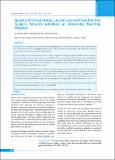Please use this identifier to cite or link to this item:
https://hdl.handle.net/20.500.14356/1655Full metadata record
| DC Field | Value | Language |
|---|---|---|
| dc.contributor.author | Shah, Jay N | - |
| dc.contributor.author | Maharjan, Shantbir | - |
| dc.contributor.author | Shah, Shailendra | - |
| dc.date.accessioned | 2023-05-17T09:32:14Z | - |
| dc.date.available | 2023-05-17T09:32:14Z | - |
| dc.date.issued | 2017 | - |
| dc.identifier.citation | ShahJ. N., MaharjanS., & ShahS. (2017). Quality of Clinical Notes: Lesson Learned from Elective Surgery Patients Admitted at University Teaching Hospital. Journal of Nepal Health Research Council, 15(2), 100-104. https://doi.org/10.33314/jnhrc.v15i2.916 | en_US |
| dc.identifier.issn | Print ISSN: 1727-5482; Online ISSN: 1999-6217 | - |
| dc.identifier.uri | http://103.69.126.140:8080/handle/20.500.14356/1655 | - |
| dc.description | Original Article | en_US |
| dc.description.abstract | Abstract Background: Informative relevant documentation regarding course of treatment minimizes errors, provides data for evidence based practice and legality. However, the clinical notes are often inadequate. This study aims to analyse quality of structured clinical notes in surgical patients. Methods: This cross sectional study from Oct 1, 2015 in department of surgery included 100 clinical notes randomly selected by lottery. The entries in notes were predefined. There were 29 general entries (nine for identification, eleven for admission details, eight for treatment progress, and one for handwriting). Three additional entries were for discharge patients. The decision for entries was based on consensus meeting in surgery department. Microsoft excel was used for data entry and descriptive analysis. Results: There were 100 clinical notes analysed, 62 non-discharge and 38 discharge patients. Four (out of 62) non-discharge had all 29 entries documented. Two (out of 38) in discharge had all 32 entries documented. The “date of entries, clinician name and designation†were mentioned in 12%, 13% and 10%, respectively. The progress on diet was recorded in 53%, investigations in 72% and intervention details in 73%. Handwriting was difficult to read in 21%. In 13 (out of 100) the identification information was incomplete. Discharge lacked details of home advice in 11%. Conclusions: The quality of clinical note of elective surgery patients needs improvement on documentation in all domains of identification, admission, progress and discharge. Keywords: Admission discharge information; elective surgery; quality of clinical notes; tertiary care teaching hospital. | en_US |
| dc.language.iso | en | en_US |
| dc.publisher | Nepal Health Research Council | en_US |
| dc.relation.ispartofseries | May-Aug, 2017;916 | - |
| dc.subject | Admission discharge information | en_US |
| dc.subject | Elective surgery | en_US |
| dc.subject | Quality of clinical notes | en_US |
| dc.subject | Tertiary care teaching hospital | en_US |
| dc.title | Quality of Clinical Notes: Lesson Learned from Elective Surgery Patients Admitted at University Teaching Hospital | en_US |
| dc.type | Journal Article | en_US |
| Appears in Collections: | Vol 5 No 2 Issue 36 May-Aug 2017 | |
Files in This Item:
| File | Description | Size | Format | |
|---|---|---|---|---|
| 916-Article Text-2319-2-10-20170910.pdf | Fulltext Download | 191.71 kB | Adobe PDF |  View/Open |
Items in DSpace are protected by copyright, with all rights reserved, unless otherwise indicated.
